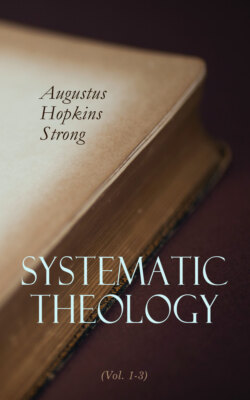Читать книгу Systematic Theology (Vol. 1-3) - Augustus Hopkins Strong - Страница 32
На сайте Литреса книга снята с продажи.
IV. Order of Treatment in Systematic Theology.
ОглавлениеTable of Contents
1. Various methods of arranging the topics of a theological system.
(a) The Analytical method of Calixtus begins with the assumed end of all things, blessedness, and thence passes to the means by which it is secured. (b) The Trinitarian method of Leydecker and Martensen regards Christian doctrine as a manifestation successively of the Father, Son and Holy Spirit. (c) The Federal method of Cocceius, Witsius, and Boston treats theology under the two covenants. (d) The Anthropological method of Chalmers and Rothe; the former beginning with the Disease of Man and passing to the Remedy; the latter dividing his Dogmatik into the Consciousness of Sin and the Consciousness of Redemption. (e) The Christological method of Hase, Thomasius and Andrew Fuller treats of God, man, and sin, as presuppositions of the person and work of Christ. Mention may also be made of (f) The Historical method, followed by Ursinus, and adopted in Jonathan Edwards's History of Redemption; and (g) The Allegorical method of Dannhauer, in which man is described as a wanderer, life as a road, the Holy Spirit as a light, the church as a candlestick, God as the end, and heaven as the home; so Bunyan's Holy War, and Howe's Living Temple.
See Calixtus, Epitome Theologiæ; Leydecker, De Œconomia trium Personarum in Negotio Salutis humanæ; Martensen (1808–1884), Christian Dogmatics; Cocceius, Summa Theologiæ, and Summa Doctrinæ de Fœdere et Testamento Dei, in Works, vol. vi; Witsius, The Economy of the Covenants; Boston, A Complete Body of Divinity (in Works, vol. 1 and 2), Questions in Divinity (vol. 6), Human Nature in its Fourfold State (vol. 8); Chalmers, Institutes of Theology; Rothe (1799–1867), Dogmatik, and Theologische Ethik; Hase (1800–1890), Evangelische Dogmatik; Thomasius (1802–1875), Christi Person und Werk; Fuller, Gospel Worthy of all Acceptation (in Works, 2:328–416), and Letters on Systematic Divinity (1:684–711); Ursinus (1534–1583), Loci Theologici (in Works, 1:426–909); Dannhauer (1603–1666) Hodosophia Christiana, seu Theologia Positiva in Methodum redacta. Jonathan Edwards's so-called History of Redemption was in reality a system of theology in historical form. It “was to begin and end with eternity, all great events and epochs in time being viewed ‘sub specie eternitatis.’ The three worlds—heaven, earth and hell—were to be the scenes of this grand drama. It was to include the topics of theology as living factors, each in its own place,” and all forming a complete and harmonious whole; see Allen, Jonathan Edwards, 379, 380.
2. The Synthetic Method, which we adopt in this compendium, is both the most common and the most logical method of arranging the topics of theology. This method proceeds from causes to effects, or, in the language of Hagenbach (Hist. Doctrine, 2:152), “starts from the highest principle, God, and proceeds to man, Christ, redemption, and finally to the end of all things.” In such a treatment of theology we may best arrange our topics in the following order:
1st. The existence of God.
2d. The Scriptures a revelation from God.
3d. The nature, decrees and works of God.
4th. Man, in his original likeness to God and subsequent apostasy.
5th. Redemption, through the work of Christ and of the Holy Spirit.
6th. The nature and laws of the Christian church.
7th. The end of the present system of things.
